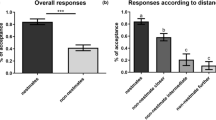Abstract
We postulated that kariomones and pheromones function to organize egg capsule deposition and breeding aggregations of mud snails (Ilyanassa obsoleta). Sexually active male and female mud snails were exposed to water-born odors from juvenile snails, nonaggregated female snails, oysters, egg capsule depositing snails, sexually active males, sexually active females, and copulating snails and tested for a follow response using a ring assay. Neither sex responded to juvenile odor or to odor of sexually inactive females. Snails turned and followed water born odors from oysters. when tested with the odors of sexually active males, sexually active females, and copulating pairs, we found sex-specific differences in responses. Sexually active females followed the odor of sexually active males and ignored sexually active female odor. Sexually active males followed the odor of sexually active females and ignored sexually active male odor. Both sexes followed the odor of copulating pairs and egg capsule depositing snails. Snail activities in breeding aggregations are organized by at least three pheromones and one kariomone, and reflect the multifunctionaLity of the aggregations.
Similar content being viewed by others
References
Duval, M. A., Calzeita, A. M., and Rittschof, D. 1994. Behavioral responses of Littoraria irrorata (Say) to water-borne odors. J. Chem. Ecol. 20:3321–3334.
Painter, S. D. 1992. Coordination of reproductive activity in Aplysia: Peptide neurohormones, neurotransmitters, and pheromones encoded by the egg-laying hormone family of genes. Biol Bull. 183:165–172.
Painter, S. D., Chong, M. G., Wong, M. A., Gray, A., Cormier, J., and Nagle, G. T. 1991. Relative contributions of the egg layer and egg cordon to pheromonal attraction and the induction of mating and egg-laying activity in Aplysia. Biol. Bull. 181:81–94.
Rahman, Y. J., Forward, R. B., Jr., and Rittschof, D. 2000. Responses of snails and periwinkles to environmental odors and disaccharide mimics of fish odor. J. Chem. Ecol. 26:679–696.
Rittschof, D., Sawardecker, P., and Petry, C. 2002. Chemical mediation of egg capsule deposition by mud snails. J. Chem. Ecol. 28:2257–2269.
Smith, B. S. 1980. The estuarine mud snail, Nassarius obsoletis: abnormalities in the reproductive system. J. Mollusc. Stud. 46:247–256.
Ting, J. H., Kelly, L. S., and Snell, T. W. 2000. Identification of sex, age and species specific proteins on the surface of the harpacticoid copepod Tririopus japonicus. Marine Biol. 137:31–37.
Walpole, R. E. 1974. Introduction to Statistics. Macmillan, New York, 340pp.
Author information
Authors and Affiliations
Corresponding author
Rights and permissions
About this article
Cite this article
Moomjian, L., Nystrom, S. & Rittschof, D. Behavioral Responses of Sexually Active Mud Snails: Kariomones and Pheromones. J Chem Ecol 29, 497–501 (2003). https://doi.org/10.1023/A:1022603728239
Issue Date:
DOI: https://doi.org/10.1023/A:1022603728239




